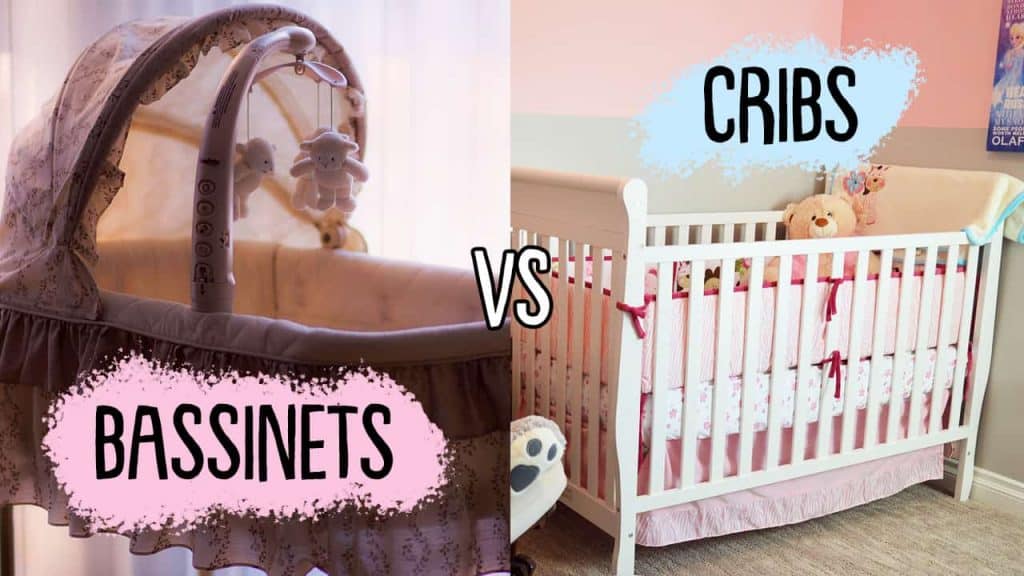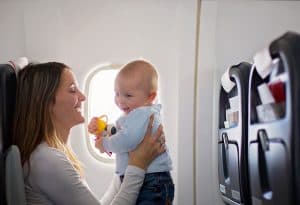
Table of Contents
Choosing what to purchase for your nest may quickly become daunting. Is a changing table really necessary? What is the significance of a rocking chair? Is a swing worth the space it consumes?
However, these are some of the most essential nursery furniture selections you’ll make which will decide where your kid will sleep. Since newborns sleep a lot, they will spend a significant amount of time in the napping area. Furthermore, keeping your kid secure when napping is critical when dealing with a newborn.
Both bassinets and cribs can be safe sleeping areas for newborns. However, both of them have certain differences, with the size being the obvious one. A bassinet will consume just a fraction of the space in comparison to the crib. Bassinets also come with a hood and low sides. On the other hand, cribs are durable because they will last your baby through their toddler years. It’s an investment that has no weight limits, unlike a bassinet. So, is it best to get a crib or a bassinet for the first few months of your little one?
Here’s how they compare and how you can pick which one is right for you.
Bassinet vs Crib: Definition of a Bassinet and a Crib
What is a Bassinet?
Bassinets and cribs have different classifications according to the Consumer Product Safety Commission (CPSC). It states a bassinet is a tiny bed primarily designed to deliver a safe sleeping environment for newborns. They are supported by a fixed frame/stand, independent legs, a rocking base, or a wheeled base.
A bassinet can also be something that can be connected to another surface, for as the little detachable newborn bassinets are seen on many modern playpens and play yards. Some strollers may have a newborn bassinet or a detachable bassinet that can be removed for travel, nevertheless, they must also adhere to safety regulations.
Pro Tip: Once your munchkin reaches 20 pounds of weight or can easily roll over (back to stomach and stomach to back), a bassinet is no longer a safe sleeping option. Based on the growth and development of your little one, transition them out of the bassinet by the age of 4 months.
What is a Crib?
As per the CPCS, there are two kinds of cribs:
Non-full-size cribs
Full-size cribs
A full-size crib is defined as a sleeping place for a baby with inside dimensions of 28 5/8 inches (71 1.6 centimeters) in width and 52 3/8 5/8 inches (133 1.6 centimeters) in length, according to the CPCS. The crib must also meet at least one of the following requirements to be categorized as a crib but not a full-size crib:
It can fold or collapse without being disassembled, making it smaller when not in use.
It lacks the meshes, nets, and screens seen in a playpen.
It features rigid sides and legs that are detachable.
It’s round, hexagonal, or any other unusual crib shape.
Cribs come in a variety of sizes, shapes, and styles. Scroll down to check out the different types of cribs:
Traditional crib: A standard or traditional crib is rectangular in shape and lacks any extra features. These are simple and effective sleeping options that are super easy to set up. It needs a crib mattress of 52 inches long and 28 inches in width.
Mini crib: These cribs are also rectangular in shape but a little tinier than traditional ones. You can use crib mattresses sizes 38 inches long and 24 inches wide in these mini cribs.
Convertible crib: These are also rectangular and can be converted into a daybed or a toddler bed once your baby outgrows the traditional crib. Its setup is a bit extensive and it comes in the higher price range. But it could be an investment in the long run when your baby is a toddler.
Round crib: These are not very common and their unique design makes them expensive. However, its size and style will give your baby enough space to play and move around.
Bassinet vs Crib: How are They Different?
A newborn can sleep safely in either a crib or a bassinet. They do, however, contain some significant variances. Here’s what you should consider before buying a bassinet or a crib:
- The most obvious difference is size – a crib takes up far more space than a bassinet, thus a bassinet may be preferable in a smaller home.
- Bassinets are also more portable due to their tiny size.
- Furthermore, many bassinets feature a hood or cover that you may pull over your sleeping infant.
- Bassinets are also more convenient for many parents to utilize. Since their sides are lower, you don’t have to lean over the rail to place the infant inside.
- Cribs, on the other hand, may be used for considerably longer periods, with some even converting to toddler beds and lasting for years.
- Bassinets have weight restrictions and are often only used for the first few months of a baby’s life.
- Cribs are more expensive than bassinets, but because they last longer, the overall investment is lesser if you move directly to a crib.
Pros and Cons of Bassinets: Things to Remember While Buying a Bassinet
Pros
- Perfect bed for babies: To help lower the incidence of SIDS, the Centers for Disease Control and Prevention urges that babies sleep in their parents’ room in a different bed (like a crib or a bassinet). A bassinet, because of its modest size, might be an excellent choice for keeping your infant close during the night.
- Mobile: Many bassinets have wheels, but even if they don’t, they’re lightweight and portable. Because of their mobility, they are an excellent choice if you want your baby to sleep safely next to you at all times, in any area of the house.
- Low height: Even getting up and moving about may be difficult for new parents, let alone stooping over the bars of a crib to pick up a baby! Bassinets are lower in height and have lower sides. This makes it easy to put down the baby and pull them out.
- Easy for recovering moms: Bassinets can be especially useful for mothers who have back difficulties or are healing from a C-section.
Cons
- Weight limitation: Bassinets are not made to last your baby for a long period. Most bassinets come with a weight limit of 15 to 20 pounds and work well for babies 4 to 6 months old. Eventually, you will need to move your baby from a bassinet to a crib.
- Short-term use: Unless you plan on having more children in the future, it’s a short-term sleeping solution.
- More spent in the long run: While bassinets are less expensive upfront, they will cost you more money in the long term because you are purchasing two distinct products.
Pros and Cons of Cribs: Things to Remember Before You Buy a Crib
Pros
- Reduces the risk of SIDS: The holes between crib slats enable air to pass through, creating a cool and soothing atmosphere for your infant. Not only will this make your baby happier, but it may help lower your baby’s risk of SIDS by up to 70%.
- Durability: Cribs are more durable than bassinets and are meant to last. This means they’re less likely to collapse while your youngster is inside. Furthermore, youngsters with greater mobility will have difficulty getting out of them, safeguarding them from any falls.
Cons
- Height: Moms who have back difficulties, are recuperating from a C-section, or are on the shorter side may struggle with a crib’s height.
- Chances of your baby falling from your hands: These elements may also enhance your chances of dropping your infant if you are not steady when bending over the railings to place them down.
Bassinet vs Crib: How to Choose Between The Two?
- Choose the sleeping area: The first thing you should consider when deciding whether to buy a bassinet vs a crib for newborns is where you want your kid to sleep in your home. The Centers for Disease Control and Prevention advises that infants sleep in their parents’ room in a separate sleeping area. If your master bedroom is small, it may be tough to put a crib alongside your bed. For the first few months, a bassinet might be a wise purchase. Even if you have a large house, you may want to consider a bassinet because of its mobility. You may then move the bassinet around the house to keep your baby near to you during naps and at night.
- Consider your budget: A bassinet is less expensive if you don’t have a lot of money to invest right away. Since the bassinet will only last a few months, you’ll still need to purchase a crib later, but this allows you to spread out the expense of nursery furnishings over time rather than purchasing it all before your kid comes.
- How long do you want to use it: The ease of usage is yet another point to remember while considering buying bassinets or cribs. Because the edges of a crib are considerably higher than those of a bassinet, it might be difficult to set your baby down and pick him up, especially if you’re recuperating from a traumatic birth or a cesarean delivery. Since the edges of a bassinet are shorter than your arms, you can simply place your infant down without having to lean over.
- Does it appeal to your aesthetics: Finally, some parents prefer a bassinet primarily for aesthetic reasons. Although cribs are safe for babies, they might appear barren and unpleasant, especially if you adhere to the suggested rules and do not use any cushions or blankets. Since a bassinet is smaller and cozier, it does not appear as sparse and large as a newborn.
Bassinet vs Crib: 3 Things You Should Check Before Buying
Here are some points to keep in mind when comparing a bassinet and a crib:
- Safety: The most critical characteristic to look for is the overall safety of your prospective bassinet or crib. Though you’d want to assume that all baby products are built with the utmost care, there are a lot of recalled and unsafe cribs and bassinets on the market that wound up in shopping carts. Safety is paramount, so be certain that your preferred baby bassinet or crib meets the most recent US Consumer Product Safety Commission regulations.
- Assembly: Knowing that both alternatives are not only exceedingly simple to put together, but also incredibly simple to operate, provides you with the peace of mind you require. A tough-to-assemble bassinet or cot is as difficult to disassemble—make your life easier by buying a sleeper that a novice builder could assemble.
- Quality: Don’t make the mistake of selecting a low-cost cot or bassinet that sacrifices quality for an excessively low price. Find a constructed replica of your ideal crib or bassinet if feasible so you can examine the device in its entirety. Anything that seems weak or easily broken should be considered a red flag.
What’s More Important: Bassinet vs Crib?
Whether you go with a crib or a bassinet, ensure your baby’s bed follows the most modern safety regulations.
- Your baby’s mattress should be firm, level, and naked, with no more than two fingers’ width between the mattress and the bed’s edge.
- If your baby’s bed contains slats, they should be no more than 2 3/8 inches apart, so his or her head cannot fit between them.
- You should never put your baby’s bed near any hanging wires or curtains, as they might cause strangling.
- You should never use additional padding or sleep positioners, and you should always put your baby to sleep on her back.
- If you acquire a second-hand crib, make sure it meets the Consumer Product Safety Commission’s safety guidelines.
Even if you bought your baby’s bed brand new, you should always inspect it before using it. Check that all of the hardware is tightened and that you have followed all of the directions for appropriate assembly. If you buy a secondhand bed, be sure it doesn’t have any damage that might cause it to break.
Bassinet vs Crib for Newborns: What Do Researchers Say?
What do the findings of the study say about cribs vs bassinets? According to one study, bassinets provide a little higher risk than cribs due to the possibility of the bassinet failing or the mechanics malfunctioning, resulting in an infant’s death.
The infants’ deaths were linked to a range of dangerous sleep behaviors, including 37 % being placed face-down to sleep and 74% having soft bedding in the bassinet with them. In 17 %of the cases, “certain technical flaws” with the bassinet were found to be the cause of the infants’ deaths, according to the report.
However, the study did not state that these bassinets must be banned or that the parents should never use one again. They did advise, however, that parents double-check that any bassinet they buy is in good functioning order and that they take extra steps to avoid placing anything in the bassinet, including bedding.
The Bottom Line: Who’s The Winner Between Bassinet vs Crib?
Although the decision might come across as a major one right now, the distinctions between bassinets and cribs are primarily a matter of personal preference. Even a crib will only last your child a few years. You’ll be looking for a huge kids’ bed again before you know it.
Choosing between a bassinet and crib is not the same as choosing between canned or jarred purees. Babies usually spend a significant amount of time being fast asleep, therefore, it is important to invest in a device that is both durable and comfy and is well worth your effort.
The age-old dispute between bassinets and cribs is still raging. Though it ultimately boils down to personal choice, there is a lot to think about before making your final decision.
Bassinet vs Crib for Newborns FAQs:
1) When does a baby outgrow a bassinet?
2) Can a newborn sleep in a crib right away?
3) What is the purpose of a bassinet?
4) Is a crib or bassinet better for a newborn?
5) Are cribs good for babies?
Sources:
- http://www.cpsc.gov/en/Newsroom/Multimedia/?vid=61685
- https://www.cpsc.gov/Regulations-Laws–Standards/Rulemaking/Final-and-Proposed-Rules/Bassinets
- http://www.cdc.gov/sids/parents-caregivers.htm
- https://safetosleep.nichd.nih.gov/research/science/other
- https://www.ncbi.nlm.nih.gov/books/NBK513399/
- https://www.cpsc.gov/SafeSleep#:~:text=With%20any%20crib%2C%20bassinet%20or,Back%20to%20the%20Basics!&text=To%20prevent%20suffocation%2C%20never%20place,in%20a%20baby’s%20sleep%20environment.&text=Make%20sure%20there%20are%20no,the%20crib%20and%20the%20mattress.
- https://www.ncbi.nlm.nih.gov/pmc/articles/PMC2575771/
- https://www.aap.org/en/news-room/news-releases/aap/2020/tips-for-keeping-infants-safe-during-sleep-from-the-american-academy-of-pediatrics/
Reviewed By :

Nimrat Sidhu - Pediatration
Dr. Nimrat S Sidhu is a practicing pediatrician for about 5 years now and holds an MD pediatrics degree. She was the topper of her batch, has always had a keen interest in her core medical field, and is specially trained for neonatal resuscitation.
She has published multiple research papers on pediatrics and is interested in topics like Neonatal care, skincare, baby growth, vaccination, growth, and development.










